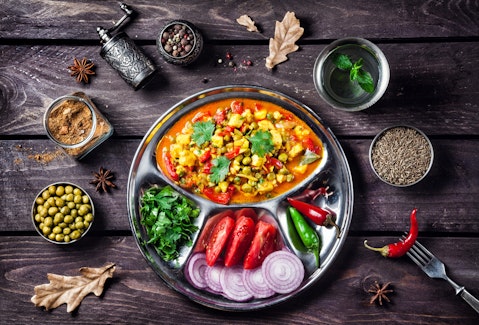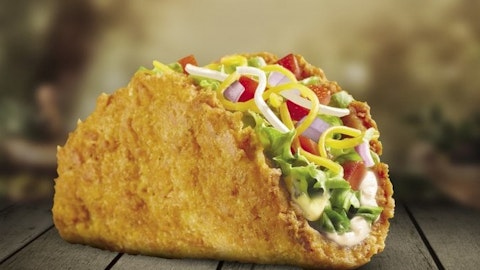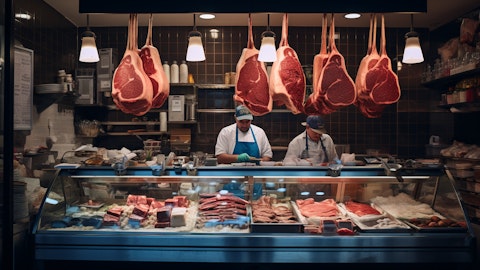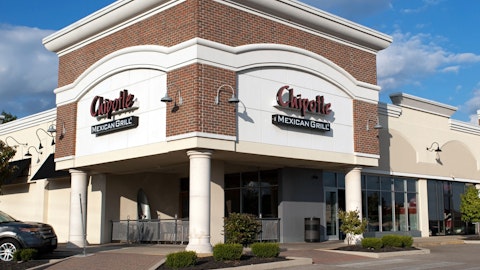Chipotle Mexican Grill, Inc. (NYSE:CMG) Q3 2023 Earnings Call Transcript October 27, 2023
Operator: Good day, and welcome to the Chipotle Mexican Grill Third Quarter 2023 Results Conference Call. All participants will be in listen-only mode. [Operator Instructions]. After today’s presentation, there will be an opportunity to ask questions. [Operator Instructions]. Please note this event is being recorded. I would now like to turn the conference over to Cindy Olsen, Head of Investor Relations and Strategy. Please go ahead.
Cindy Olsen: Hello, everyone, and welcome to our third quarter fiscal 2023 earnings call. By now, you should have access to our earnings press release. If not, it may be found on our Investor Relations Web site at ir.chipotle.com. I will begin by reminding you that certain statements and projections made in this presentation about our future business and financial results constitute forward-looking statements. These statements are based on management’s current business and market expectations, and our actual results could differ materially from those projections in the forward-looking statements. Please see the risk factors contained in our Annual Report on Form 10-K and in our Form 10-Q for a discussion of risks that may cause our actual results to vary from these forward-looking statements.

Pikoso.kz/Shutterstock.com
Our discussion today will include non-GAAP financial measures. A reconciliation to GAAP measures can be found via the link included on the presentation page within the Investor Relations section of our Web site. We will start today’s call with prepared remarks from Brian Niccol, Chairman and Chief Executive Officer; and Jack Hartung, Chief Financial and Administrative Officer, after which we will take your questions. Our entire Executive leadership team is available during the Q&A session. And with that, I’ll turn the call over to Brian.
Brian Niccol: Thanks, Cindy, and good afternoon, everyone. Our focus on exceptional food and exceptional people continues to drive strong results, including positive transaction trends that accelerated throughout the quarter. For the quarter, sales grew over 11% to reach $2.5 billion driven by a 5% comp. Digital sales represented 37% of sales. Restaurant level margin was 26.3%, an increase of 100 basis points year-over-year. Adjusted diluted EPS was $11.36, representing 19% growth over last year and we opened 62 new restaurants, including 54 Chipotlanes. Trends remain strong in October and we anticipate comps in the mid to high single digit range for the fourth quarter, which includes our recent pricing action. Before updating on our strategic priorities, I’m thrilled to share that Laura Fuentes has joined our Board of Directors.
Laura is the Executive Vice President and Chief Human Resources Officer of Hilton Worldwide with extensive experience in global hospitality and people leadership, and will be pivotal in helping Chipotle deliver against our five key strategies that position us to win today while we grow our future. These include running successful restaurants with a people accountable culture that provides great food with integrity while delivering exceptional in-restaurant and digital experiences; sustaining world class people leadership by developing and retaining diverse talent at every level; making the brand visible, relevant and loved to improve overall guests engagement; amplifying technology and innovation to drive growth and productivity at our restaurants and support centers; and expanding access convenience by accelerating new restaurant openings and laying the foundation for international expansion.
Beginning with running successful restaurants with a people accountable culture. It was exactly a year ago that we made a big effort internally to get back to Chipotle standard of excellence and I’m proud of the progress our restaurant teams have made over the course of the year. This includes staffing and turnover that are back to or better than pre-pandemic levels. Restaurants that are prepped and ready resulting in fewer outages, improvements in on-time and accuracy on the digital make line and continued progress on throughput. Our focus on ops is strengthening a core piece of our value proposition which is customized, delicious culinary served quickly with great hospitality. As a result of improvements in operational execution, along with keeping our menu pricing accessible, our value proposition has never been stronger.
This is certainly translating to great results with transaction comps positive all year and up over 4% in the third quarter. While we are sitting on a strong foundation, we see an opportunity to be even better, particularly when it comes to throughput. We have two key initiatives that we recently rolled out that we believe will drive further improvement. The first is adjusting the cadence of digital orders to better balance the deployment of labor, eliminating the need to pull a crew member from the front make line to help the digital make line during peak periods. And the second is a renewed focus on throughput training in our restaurants by bringing back a coaching tool that we had in place prior to the pandemic. Feedback from our restaurant teams on these two initiatives has been very positive, and we’re seeing that restaurants that have the right cadence of orders on the digital make line and that are executing the four pillars of throughput are seeing an improvement of four to five entrees in their peak 15-minute period.
As I mentioned in the past, we hold our teams to a high standard because when they achieve it, they feel like they are part of a winning team with the ability to be rewarded through bonuses and growth within the organization. For our crew members, throughput is a key performance factor in the crew member bonus plan. It is also a component of the bonus measure for general managers, field leaders, team directors and regional vice presidents. As we coach and make progress on throughput, they will enable more restaurants to achieve their quarterly bonus and importantly will drive a better overall experience for our guests and our teams. Speaking of our teams, we recently brought back our Behind the Foil campaign which features our crew members giving a glimpse into daily preparation using real ingredients in classic culinary techniques, a key differentiator for Chipotle.
The fact is we don’t have freezers in our restaurants and our teams begin preparing at 6 o’clock or 7 o’clock in the morning to be able to serve our delicious food by the time we open at 10.30. This includes grilling Fajita Veggies and Adobo Chicken on the Plancha, slicing and dicing onions, jalapenos, and cilantro by hand. Also hand mashing avocados to make our signature guacamole and making our chips fresh every day. This campaign is a great way to put a spotlight on our talented teams and their hard work to prepare our exceptional food. One of our team directors that was featured in Behind the Foil started as a crew member and within seven years moved his way up to team director managing a sub region of 49 restaurants at just 29 years old.
His passion for the brand and helping to deliver an excellent customer experience has driven his success. In fact, he is one of the best performing sub regions across the company. He truly believes in Chipotle’s purpose and wants the position [ph] to be able to replicate the same opportunities that have been given to him. Our people are our greatest asset and developing future leaders is critical delivering on our growth goals of reaching 7,000 restaurants longer term and surpassing 90% internal promotions. We will continue to find ways like our Behind the Foil campaign to celebrate our team’s growth, hard work, success and passion for Chipotle. In addition to this campaign, our marketing team has done an outstanding job in finding authentic ways to make the brand more visible, more relevant and more loved.
Last month, we brought back our fan favorite and highly requested Carne Asada as a limited time offer and the reception has surpassed our expectations. Carne Asada is a delicious combination of responsibly raised premium cuts of steak seasoned on the grill with a blend of signature spices that’s finished with freshly squeezed lime and hand chopped cilantro. We also introduced an entirely new way to try Carne Asada with the Carne Asada Quesadilla, and it’s just truly delicious. I’m really proud of the cross functional effort it took to make sure we could bring back this popular LTO which is especially impressive given that we estimate only about 5% of U.S. beef meets our food with integrity standards. In sports, as college football season kicked off, we leveraged our Real Food for Real Athletes platform to partner with players and teams to showcase their inspiring journeys, their love for Chipotle and how our food can help them perform their best by providing proper nutrition.
We also leveraged creative gaming integrations as a fun way to connect with some of our biggest fans. We brought back Chipotle IQ in August as a one-of-a-kind digital trivia game testing the knowledge of Chipotle’s real ingredients, leading food standards, culinary techniques, sustainability efforts, brand history and community engagement. Shifting to an amplifying technology, we’re making progress on a couple of innovations that ultimately could help to improve the overall experience for our restaurant teams and our guests. The first is our automated digital make line, which we recently installed at our Cultivate Center to test and learn on. Through our partnership with Hyphen, we’ve been testing the Hyphen make line which fits into our existing digital make line footprint and automatically makes bowls down below with the ability for our team to build tacos, burritos, kids meals and quesadillas on top.
There are many reasons why we are excited about automating the digital make line, such as increased capacity and improved speed and accuracy, which can further help with the balance of labor between the front make line and the digital make line. Additionally, Autocado which cuts, cores and scoops avocados is also at our Cultivate Center, and our restaurant teams are providing feedback to be included in the next phase of the prototype. As we mentioned last quarter, Autocado could save time and eliminate a less favorable task but still allow for one of their favorite parts of the job, which is that in freshly chopped onions, jalapenos and cilantro, seasoned with some citrus and salt and hand mash or signature guac. While we still have some iterations to make the Hyphen and Autocado before they are ready to be tested in a restaurant, I am excited about the progress the team is making and we will continue to provide updates on the path through the stage gate process.
Finally, moving to expanding access and convenience. We are on track to reach our guidance range of opening between 255 to 285 new restaurants this year, which will mark a record for the company and we surpassed 700 Chipotlanes this quarter. As we look out to 2024, we anticipate opening between 285 to 315 new restaurants with at least 80% having a Chipotlane. This month, we opened our first location in Calgary. This was the first entrance into a new market in Canada since we entered Vancouver in 2012, and it’s clear there’s strong demand for Chipotle with opening day sales hitting a new company record. The team in Canada has done an outstanding job with company leading throughput on the front line and on time and accuracy on the digital make line.
AUVs margins and returns are on par with the U.S., and I remain very confident in Canada’s long-term growth potential. Outside of North America, we have outlined a plan for Europe to deliver economics that would support accelerated growth. This includes improving our operations by aligning our training tools, systems and culinary with our U.S. operations where it makes sense and is feasible, as well as building brand awareness. Similar to our strategy when we first entered new markets in the U.S., we were building brand awareness in Europe to more local initiatives like partnering with local universities, local sports teams and focusing on activities which gets our food into the hands of potential guests. The good news is our restaurants are staffed, stable and the talent we have coming through is exciting.
Finally, in the Middle East, we are collaborating with Alshaya Group across development, culinary, supply chain and food safety to support a successful opening of our restaurants next year in Kuwait and Dubai. In closing, I remain really excited about all the growth ahead of us both in the U.S. and internationally. I want to thank our restaurant and support center teams for all their hard work and dedication to Chipotle. Our results demonstrate that we have a winning team that sets high standards and delivers. We have a lot of opportunity in front of us and we will continue to push the boundaries of what is possible in terms of running great restaurants with exceptional people, exceptional food and fast throughput. I am more confident than ever that we have created the foundation to achieve our aggressive growth goals and further our purpose of cultivating a better world.
With that, I’ll turn it over to Jack.
Jack Hartung: Thanks, Brian, and good afternoon, everyone. Sales in the third quarter grew over 11% year-over-year to reach $2.5 billion as comp sales grew 5% with over 4% transaction growth. Restaurant level margin of 26.3% increased about 100 basis points compared to last year. And earnings per share adjusted for unusual items was $11.36, representing 19% year-over-year growth. The third quarter had $1 million in unusual expenses related to corporate restructuring. Looking ahead to Q4, based on the trends we’ve seen so far in the quarter, including mid single digit transaction comps, we anticipate comps in the mid to high single digit range, which includes our recent price increase of about 3%. As a reminder, in the fourth quarter, we will reevaluate estimated loyalty breakage for points projected to expire, which may require a catch-up adjustment that could have a negative or positive impact on our comp and that’s not factored into our guidance.
We continue to forecast full year comps in the mid to high single digit range. I’ll now go through the key P&L line items, beginning with cost of sales. Cost of sales in the quarter were 29.7%, a decrease of about 10 basis points from last year. The benefit from last year’s menu price increases was mostly offset by inflation across several food costs, most notably beef and queso. For Q4, we expect our cost of sales to be right around 30% as the benefit of the menu pricing increase we just took will be offset by the mix shift from Chicken al Pastor to Carne Asada as well as higher cheese and avocado prices. Labor costs for the quarter were 24.9%, a decrease of about 20 basis points from last year. The benefit from sales leverage was mostly offset by wage inflation.
And for Q4, we expect labor costs to be in the mid 25% range as the benefit of the menu price increase will be offset by continued labor inflation. And within our guidance, we anticipate a similar level of paid time off and other benefits that we experienced in the fourth quarter of last year. Other operating costs for the quarter were 14%, a decrease of about 50 basis points from last year. This decrease was primarily driven by sales leverage. Marketing and promo costs for the quarter were 2%. And in Q4, we expect marketing costs to step up to the mid 3% range with a full year to come in just below 3%. In Q4, other operating costs are expected to be in the low 15% range. G&A for the quarter was $159 million on a GAAP basis or $158 million on a non-GAAP basis, excluding $1 million related to corporate restructuring expenses.
G&A also included $120 million in underlying G&A, $34 million related to non-cash stock compensation, $3 million related to higher bonus accruals and payroll taxes on equity vesting and exercises and $1 million related to our upcoming All Managers Conference, which is scheduled for Q1 of next year. For Q4, we expect our underlying G&A to be around $125 million and to grow slightly thereafter as we make investments in technology and people to support ongoing growth. We anticipate stock comp will be around $33 million in Q4, although this amount could move up or down based on our actual performance. We also expect to recognize about $3 million related to performance-based bonus accruals and payroll taxes and equity investing, exercises and $2 million related to our All Managers Conference, bringing our anticipated total G&A in Q4 to around $163 million.
We anticipate preopening expenses to around $15 million in Q4 due to the cadence of new restaurant openings. And as a reminder, about half of preopening expense is non-cash preopening rent related to straight line accounting rules. Depreciation for the quarter was $79 million or 3.2% of sales, and for Q4 we anticipate depreciation expenses to step up by $4 million to $5 million due to a larger number of expected new restaurant openings. Asset retirement was $7.2 million in the quarter and in Q4 we expect asset retirement to be around $8 million as we continue to focus on proactive equipment replacement as we prioritize the guest experience through great operations. Our effective tax rate for Q3 was 24.2%, which benefited from higher than expected tax credits.
We continue to estimate our underlying effective tax rate will be in the 25% to 27% range, though it may vary each quarter based on discrete items. Our balance sheet remains strong as we ended the quarter with over $1.9 billion in cash, restricted cash and investments with no debt. During the third quarter, we repurchased $226 million of our stock at an average price of $1,914, more than 2.5x our Q2 purchases as we were optimistic as the market softened. At the end of the quarter, we had $368 million remaining under our share authorization program. We opened 62 new restaurants in the third quarter, of which 54 had a Chipotlane, and we remain on track to open between 255 to 285 new restaurants this year. And as Brian mentioned, we plan to open between 285 and 315 new restaurants in 2024, of which at least 80% will have a Chipotlane.
We anticipate that our timeline will remain extended which is preventing us from reaching the higher end of our 8% to 10% new restaurant opening guidance range in 2024. We continue to see permitting and inspection delays, utility installation delays, along with developers delaying projects due to macro pressures and rising interest rates. Considering our current pipeline and timeline, and assuming conditions do not worsen from here, we believe we can approach 10% new restaurant openings by 2025. To conclude, I want to once again thank our 114,000 employees for treasuring our guests and earning every single customer visit. We have exceptional people working hard every day to serve exceptional food to our guests, and that shows through these terrific results.
As Brian mentioned, we have a lot of opportunity in front of us, and as we continue to make meaningful progress in improving the guest experience through faster throughput in our restaurants. This will further strengthen our brand and industry leading economic model, and continue to position us for long-term growth. With that, we’re happy to take your questions.
See also 13 Technology Stocks To Buy That Are Too Cheap To Ignore and 25 Most Productive Countries Per Capita.
Q&A Session
Follow Chipotle Mexican Grill Inc (NYSE:CMG)
Follow Chipotle Mexican Grill Inc (NYSE:CMG)
Operator: Thank you. We will now begin the question-and-answer session. [Operator Instructions]. Our first question comes from Sara Senatore with Bank of America. Please go ahead.
Sara Senatore: Thank you so much. I just wanted to ask about unit growth, if I may, both the U.S. and then Europe. Jack, you noted that you could get to the high end of that 8 to 10 for ’25. I guess I’m curious how or what you’re doing just sort of address the construction permitting delays I think should probably continue. Are you sort of widening the funnel in terms of the sites that you identify and the kind of work you do to start? I guess I’m trying to understand sort of the competence in getting back there assuming the environment doesn’t change that much. And then for Europe, you talked about getting economics, you could support accelerated growth, do you need to get AUVs higher or are the sales volumes there, but it’s really about kind of operational efficiency and the training that you talked about? Thanks.
Jack Hartung: Yes. Sara, I’ll start within the U.S. When we talk about getting to the high end of the 8% to 10% range by 2025, that actually assumes that we don’t get better in terms of the timeline. It assumes that things stay as they are. What that tells you is just every year, our teams are doing a great job of building a very robust pipeline. And so that pipeline is really filling up. And as these timelines have been extending, that pipeline just keeps getting bigger. And so if you just assume we have the same timelines going forward for the next couple of years, we should get close to that 10% range. Now having said that, we’ve also challenged our teams. We challenge our teams to take a look at what is causing some of the delays.
What can we do from a mix standpoint? Are there simpler deals that we can go after that would shorten the timeline? Can we work with developers if developers are getting way too far [ph], but there are things that we can do from an economic standpoint that might accommodate that? So we challenge our teams to shorten the timeline. But in terms of us getting to 10%, frankly, our pipeline we think can get us there even if the timeline stay the same? And then, Brian, I don’t know if you want to comment on Europe?
Brian Niccol: Yes, sure. So on Europe, Sara, you basically — in your question was the answer. So the top line looks really good. We’re working hard on how we get that to flow to the bottom line. So some operating efficiencies and just getting better at managing the business is really what we’re focused on.
Sara Senatore: Great. Thank you very much.
Operator: Our next question comes from David Tarantino with Baird. Please go ahead.
David Tarantino: Hi. Good afternoon. My question is about the traffic performance you’re seeing. I think Brian, you mentioned that it accelerated as the quarter went on and stayed strong in October. And we’ve been hearing I guess more broadly that the consumer spending environment may have done the opposite. So I was wondering if you could maybe unpack the drivers that you think drove the divergence that you’re seeing? And specifically, was hoping that you could talk about the comparison related to Garlic Guajillo Steak and also what you’re seeing on the throughput side as a contributor to that? Thanks.
Brian Niccol: So yes, David, our transactions actually throughout the quarter, every month showed improvement. And we continue to see that transaction strength where we are today. So the things that we’ve been focusing on is, look, get staffed, get trained, get deployed. And kind of the way we describe this is you got great people, great culinary, great throughput, and I think we’re seeing that come through in our results. Combine that with the fact that we just launched Carne Asada and the foundation of operational performance I think is critical in making Carne Asada be probably a performer that will outperform what we saw with Garlic Guajillo Steak. I know that was a favorite of yours. But I’m sorry to say that Carne Asada might outperform it.
But regardless, I think what’s really important is our operators have done a terrific job of getting back to the basics of staffing, training, deploying, and then holding ourselves accountable to great throughput, and we’re seeing every month some improvements in throughput. And that continues to be the case that we enter the fourth quarter. And I think that’s why we continue to see really good traffic results. And we’re going to protect the value proposition. We’re going to protect the brand position that we have. And I think we’ll get rewarded with hopefully more than our fair share of transactions.
Jack Hartung: Yes. And the only thing I would add Brian to that is we’re reading the same things David that you are and the consumer is clearly under pressure with inflation over the past year and pretty much everything with gas and groceries and really across the board higher interest rates. We continue to do well not just across our income levels, but with the lower income. They’re holding up really well. They’re really hanging in there at about the same level as our medium and high income levels. So I think the Chipotle value where we haven’t raised prices in over a year until this latest action I think is coming through and people are choosing to dine at Chipotle because we are very affordable.
Brian Niccol: And sorry, one other because this is a favorite topic of ours here is we do love the fact that our growth is being driven by transactions, which I do think is really important to ongoing health for our business and our opportunity to grow going forward. So really proud of the team and really proud of the result for this quarter.
David Tarantino: Great. Thank you very much.
Operator: Our next question comes from Dennis Geiger with UBS. Please go ahead.
Dennis Geiger: Great. Thank you. Wondering if there’s anything else to highlight on the strength of the margins in the third quarter? And I guess more importantly, how that’s shaping how you’re thinking about next year and specifically, Jack, if 27% margin is at $1 trillion AUV, if that’s kind of still the right way to think about the margin AUV dynamic?
Jack Hartung: Yes. I would describe our margin right now. We’re not quite at 3 million, but knock on the door, we should get there next year, and we’re knocking on the door of 27%. We’re not all the way there yet. We’re at 26.5% year-to-date and 26.3% for the quarter. Fourth quarter typically is a lower margin quarter for us. It will be closer to 26% and 27%. But I would call that knocking on the door and just give you an idea. We’re not going to do this. But if for example we chose to take an extra 1% or 1.25% in pricing, our margin would be at 27%. Now we’re not going to drive our margins based on that. We’re really using menu pricing just to offset inflation. But it gives you an idea with a little bit of extra pricing or with a little break in terms of some of the commodity costs, the ingredient costs next year.




